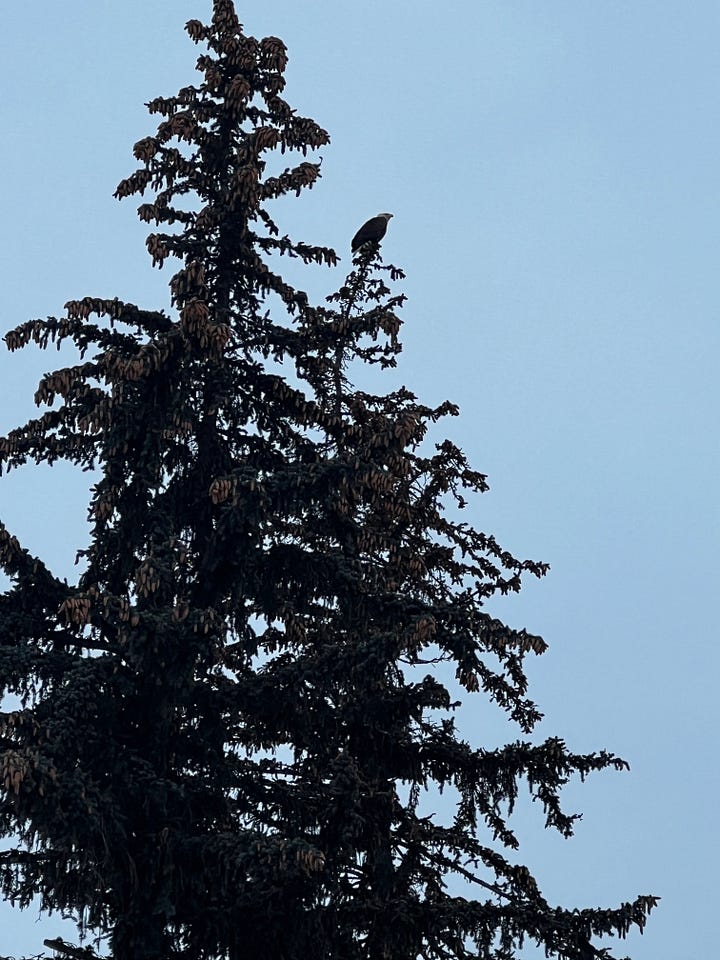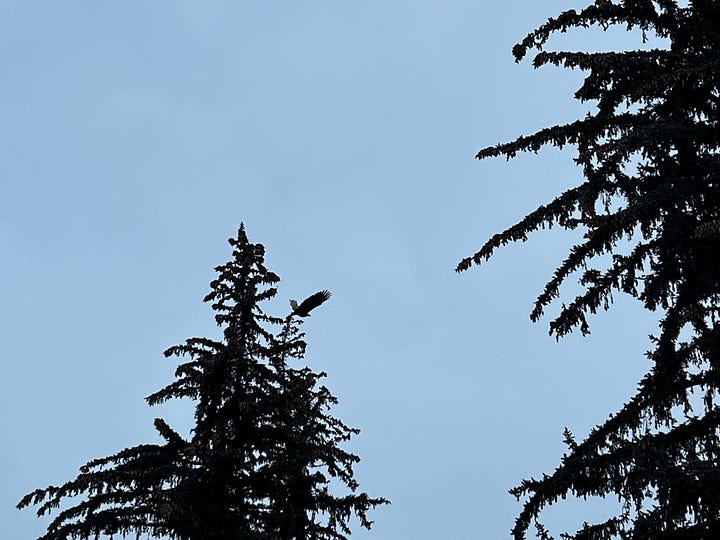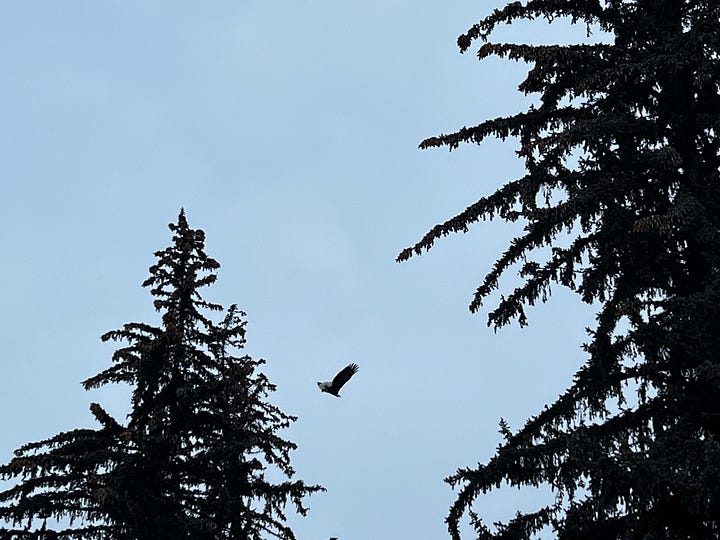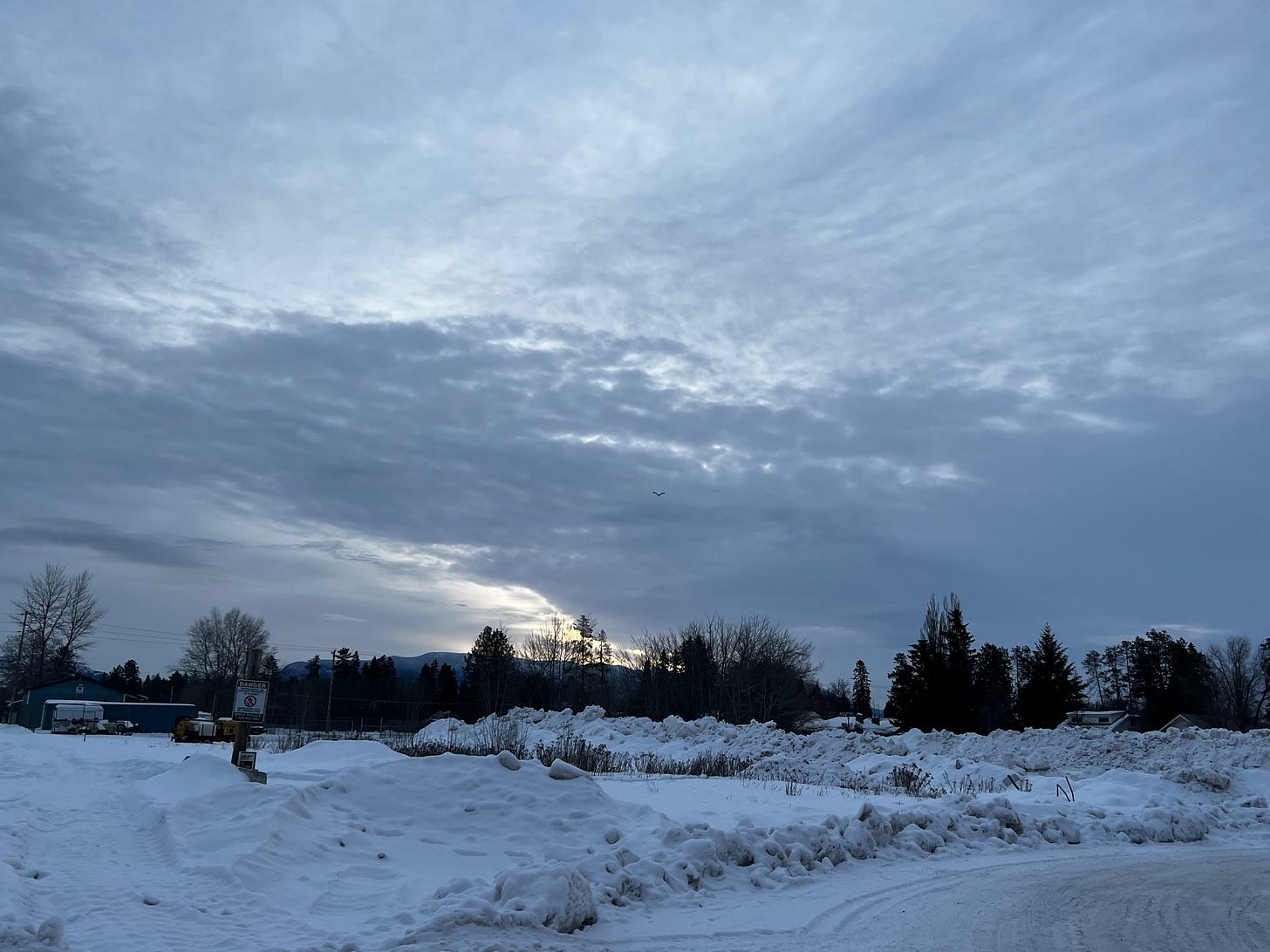"Like eagle rounding out the morning Inside us. We pray that it will be done In beauty. In beauty." —from "Eagle Poem," Joy Harjo
Last week I stood outside the middle school playground for a long time after dropping my daughter off, watching the sunrise, or what I could see of it. It tends to be overcast most of the time in winter where I live, but recently we’ve been getting some beautiful sunrise colors while rarely seeing the actual sun. It passes, somehow, from behind the mountains and into the clouds without showing itself, but still spreading its fiery colors and pastels across a sliver of sky.
While I was standing there, a friendly acquaintance drove by. (We really need a word for someone who’s more than an acquaintance, someone you’re generally happy to see, but neither you nor they feel any need to “get together.”) He told me he was headed up to the ski mountain to go skinning* with some people, and that it was a special skin because it was the anniversary of the death of the person the main skinning route, the Benny Up trail, is named after.
This person hadn’t been someone I’d known, but many of the people I’m close to did, and the whole county-wide community was affected when he died in an avalanche several years ago. My friendly acquaintance had known him well, and said he made everyone feel like their best self, that thousands would say he had been their best friend. He was just that kind of person.
One of my goals in life, this friendly acquaintance told me, is to be the person his friend thought he was. And then he left and I thought, damn. A heck of a goal, yes, but what a heck of a person to have that kind of effect in this world.
A short time after this acquaintance drove off, I was still standing there and was surprised by not one but two bald eagles flying overhead, on a direct path to somewhere.
One of the eagles aimed for the top of the trees in front of the train station a short distance away. He was hard to miss as I walked past, especially as he got ready to take off again. (I think this was a male? I can’t really tell but the wingspan looked about right.) I watched him until he was long out of sight, winging toward the mountains. I love those birds so much. Seeing one is always a gift, but two within moments of each other?




I thought about that morning for days afterward, both the conversation and the sight of the eagles. I’m still thinking about them.
How many of us have someone in our lives like my acquaintance’s friend? Someone who can see our best selves? Someone who knows our flaws and shortcomings and sees us for the fully alive human beings that we all are? How many of us ever manage to be that person for others, or even one other?
There’s a subtle difference here between someone who believes in your potential—like a parent, maybe, or a teacher, depending on the kinds of parents and teachers you had—and someone who sees what you already are, if you let yourself be that person. Like a complete inverse of how middle school feels, where you walk around raw and anxious, seeing all your flaws magnified by others’ judgment.
It’s rare to find a person like that. Who makes you think, “I want to be the person they think I am.” Who nudges us to grope past the bog-standard shame and self-doubt that come with simply being alive, and find our way to the self that was always there.
Who manages to accept all our damage and pain and failings and weaknesses and still gives us the confidence to like ourselves enough to find the best we’re capable of. Who balances out all that there is to be weary of and unhappy about in the world.
When we can’t find another human who reflects us as whole, nature can remind us of it, maybe with a flight overhead, or maybe just by being there. We are all of us limping through life in one way or another. Nature reminds us that we’re interconnected and interdependent, and also unique and miraculous. Like an eagle, or a sunrise.
*Skinning, for anyone who doesn’t know, involves sticking nylon fiber strips to the bottom of one’s skis and walking uphill, and then taking the skins off to ski down. “Are you having fun suffering?” is how my dad puts it.
Some stuff to read, listen to, or watch:
Related to last week’s Threadable-adjacent reading selection, Nick Estes’s Our History Is the Future, several people asked about Land Back in response to Estes’s writing about repatriation of land and the theft of the Black Hills in South Dakota.
This is, as I mentioned there, not something I’m an expert in. I do think it’s incredibly important. Even so, “barely informed” would be a more accurate description of my knowledge. But the question also came up in the Threadable app itself, so the list this week is devoted to starting points for anyone wanting to learn more about that subject. It is not at all comprehensive; I just want to point people to voices and groups and thoughts other than mine to learn more about land repatriation—or rematriation, which autocorrect refuses to admit is a word but I love as a way of thinking about this.
This webinar from the David Suzuki Foundation is long—about an hour and a half—but gives an overview of Land Back ideas from a variety of perspectives. Which is, as is pointed out early in the webinar, one of the commonly misunderstood points: there is no one way this looks.
Nor should there be. In the U.S. alone there are 574 recognized Native Nations and many more the federal government doesn’t recognize (a problem all on its own). If this seems like too many different nations to make Land Back attempts tenable, a reminder that Scotland is geographically not even the size of South Carolina and was ruled by hundreds of distinct clans—there are 500 listed today—until the unfortunate Jacobite Rebellion in the mid-1700s.Thanks to Julie for sending me the Nihizhí: Our Voices podcast, which has a couple of episodes (episodes 2 and 8) related to Land Back.
Also from Julie, a reminder of Estes’s own Red Nation podcast. I can’t seem to link to individual episodes, but there are several related to Land Back, including from October 4, 2020; June 28, 2021; and July 4, 2021. This last is titled “No Apologies, Land Back” and most of the episode is frank discussion of boarding schools and the Catholic Church: “The only thing that we need from the Catholic Church is the shit that they stole from us. . . . Give us our land back. All that land you took? Give that back. That’s it. No questions asked. Just give it back.”
David Treuer’s article in The Atlantic from last year making the case for returning U.S. National Parks to a consortium of Native Nations: “There is precedent for this kind of transfer. The indigenous peoples of Australia and New Zealand now control some of those countries’ most significant natural landmarks.”
A 2020 issue of the Canadian magazine Briar Patch was devoted to Land Back. It delves into many of the iterations and issues facing the movement. One article, for example, covers four case studies of “Land Back in action.”
Interviews and videos like Hesapa—A Landback Film from Landback via NDN Collective; and videos and papers from Yellowhead Institute: “The doctrine of discovery is fundamental to the existence of Crown Land in Canada. And Crown Land stands as a foundational roadblock to the possibility of land restitution. Even where Indigenous nations have proven in court the continuity of their occupation, use, and unceded title from pre-contact to the present, according to Canadian law, there is no legal pathway to resume full jurisdiction and governance authority over Indigenous lands.”
A short one from the Canadian Broadcasting Corporation about a teacher planning to return part of the 100 acres she owns (it doesn’t explain why not all of it) to the Alderville First Nation: “For me the question isn’t why, the question is how can I not do this? How can you not do everything in your power to bring about reconciliation in the best way that you can in your tiny corner of Turtle Island?”
High Country News has had a few stories related to LandBack, including this one from Wenatchee, Washington, by Manola Secaira, and B. ‘Toastie’ Oaster’s six questions about LandBack answered: “The LandBack movement is less about a mass real estate transaction than it is about sovereignty, recognition of treaties, and, ultimately, the abolition of the United States’ concept of real estate altogether. From many traditional Indigenous points of view, land ownership is an illusion, no more possible than ownership of a rainbow. Land ‘ownership’ is simply a legal concept — one that keeps wealth and power in white families.”






I call them "greenbelt moments." Sometimes when out walking or bicycling I am feeling down or feeling a little out of sorts with the human race. I'll pass someone who, for no particular reason that I'm aware of, looks at me just long enough to catch my eye and give a brief but warm smile, and says hello. That's all they do. No invite to have a conversation, meet for lunch, or spend forever together in eternal bliss. Just a passing recognition of our shared journey through this life. Just two human beings wishing one another well.
But there is power in that moment. Great power. Some might even call if magic. As if pixie dust just sprinkled from the dark cloud I had placed above my head, the world is suddenly transformed. Those ugly scales loosen and fall from around my heart. My step lightens just a bit. I feel more hopeful. The entire day takes on a new countenance. And all from that one moment of grace, all from that one moment of connection. From someone I may never see again.
I decided a few months ago that the best course of action, at least for myself, is to strive to be the kind of person who extends that moment of grace to others--wherever and whenever I can, whether to a stranger on the greenbelt, a checker at the market, or to friends and loved ones--to be the kind of person who turns someone's day around simply by extending a little kindness, a little recognition of our common humanity, or when circumstances allow by taking a few minutes to listen, to really listen. As if to say, "I see you."
I will fail, and perhaps often. After all I still must fight my own demons, and they sometimes get the best of me. But I just don't know any other way to do this.
________________________________________________
Thank you so much for providing the great resources, Antonia. And thank you for your thoughtfulness and depth of soul. You are a gem. I am grateful to have found you.
It's interesting because I feel those who really sees me and see the best and potential of me in a clear objective way are people who I am not close to at all. They are friendly acquaintance (like the ones you just described) or people from work. Perhaps because we don't have personal history neither of us are clouded by expectations of past experiences.